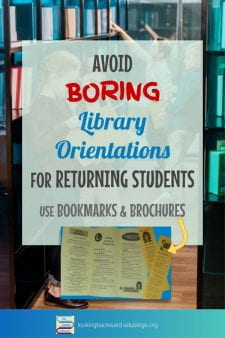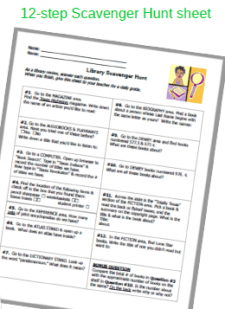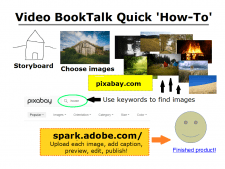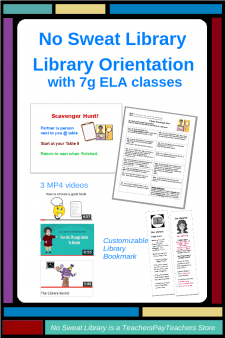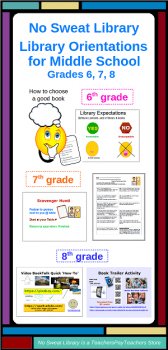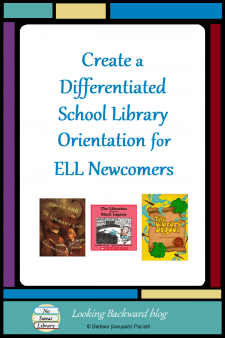 A school library orientation influences our relationship with students for the entire school year, so it’s important to have an orientation with all students in the school, including our special populations.
A school library orientation influences our relationship with students for the entire school year, so it’s important to have an orientation with all students in the school, including our special populations.
Early on I realized that, even with customized grade-level orientations for ELA classes, Newcomer English Language Learners need a customized orientation with very focused differentiation.
So, I created a Read-Aloud Orientation plan using WIDA-ELD Standards and Can-Do Descriptors that met their needs.
3 GREAT READ-ALOUDS FOR ELL NEWCOMERS
A new school is an even more “alien environment” for ELL Newcomers (who also face a new city, state, country, and language), so I spread their library orientation across 3 weekly visits that help them get to know me better and gradually build their understanding of using the School Library.
I believe ELL Newcomers need to hear English spoken fluidly—not ‘fluently’, but ‘fluidly’—so the pacing and tone of the language becomes ingrained in their minds. For that reason I read aloud a picture book about the library at each of their 3 library visits:
- Visit #1: Tomás & the Library Lady shares the Newcomers’ situation because Tomás and his family move from his home in Texas to Iowa. The local librarian helps him find wonderful books to read to his family, and this encourages our Newcomers to take their books home and practice learning English by reading to their own family.
linebreak - Visit #2: The Librarian from the Black Lagoon addresses Newcomers’ fear of things they’ve not yet experienced and helps reduce that worry through humor, as well as preparing them to learn the do’s and don’t’s of the school library.
linebreak - Visit #3: The Library Dragon highlights the joy and power of a library read-aloud. The words & phrases related to ‘fire’ preview synonyms & idioms for ELA and where students can locate different books in the library.
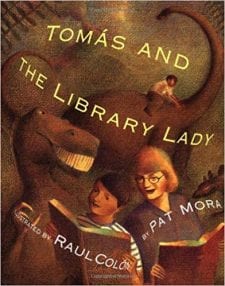 |
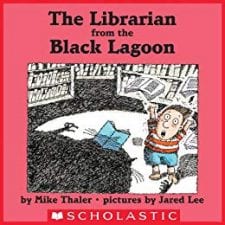 |
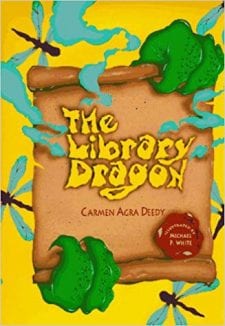 |
ATTAINABLE HANDS-ON ACTIVITIES
Yes, students, especially ELL Newcomers, love read-alouds, but ALL library visits must be purposeful if we want teachers to use valuable class time to support our library program. I use follow-up hands-on activities that help ELLs meet English Language Arts objectives for ELL Level 1 students:
- WIDA-ELD topic & academic language – word/phrase level Vocabulary Usage, sentence level Language Forms & Conventions, and discourse level Linguistic Complexity.
- Can-Do Descriptors for performance tasks in Listening, Speaking, Writing, and Reading.
- Differentiation strategies that offer sensory, graphic, and interactive support.
I chose these 3 stories because they naturally lead into activities that support classroom learning and help ELLs develop useful library skills. After the read-aloud, my modeling & guided practice activity has ELLs associate concrete visual stimuli with English language terms:
- Visit #1 supports ELA concepts of story plot and compare/contrast
- I Have, Who Has roundabout game begins with a student reading aloud the first plot question. I prompt “Who has the answer?” A student says “I have it,” reads their event, then their Who Has question. The game continues through the story, ending with the student who began.
- Tomás and Me Venn diagram helps each student recall details of the story using compare/contrast by entering how they and Tomás are the same as or different from each other.
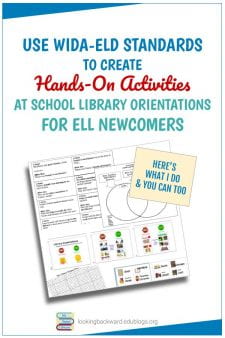
linebreak
- Visit #2 presents library expectations with a concept attainment task allowing table groups to collaborate on sorting 12 pictorial cards into YES or NO categories for actions that are OK or unacceptable. (It’s the same activity as the one for 6g, but with fewer and simpler cards.)
linebreak - Visit #3 supports ELA recall of story details and similarities using a simple word search grid of story words related to fire, and supports ELD learning about idioms with fire-related phrases from the story.
The Venn diagram and the word search/idioms worksheets
can both be used as daily grades for the ELL teacher.
ELLS USE WHAT THEY’VE LEARNED
Next, Independent practice gives students an opportunity to use what they’ve learned.
- Visit #1: Rather than confuse ELLs with navigating an unfamiliar environment, I hand-pick and lay out on tables a variety of picture books for students to browse, just as Tomás’s librarian chose books for him.
linebreak
We have quite a diverse language population, so I display our bilingual picture books (in Spanish, Hindi, Urdu, Korean, Japanese, Khmer, Vietnamese, Arabic, Persian, Tagalog) along with a selection of English picture books with stories from or about other countries and cultures. This helps ELLs feel more at home in our school library, and I encourage them to choose a book to check out and take home to read to their families, as Tomás did.
linebreak - Visit #2 also gives students time to browse for books. I still have books laid out on tables, which some prefer, but now that the library isn’t such a scary place, I show them the adjoining bookshelf sections of bilingual books, picture books, and graphic novels. Students choose at least 1 book, and at checkout they receive a special ELL bookmark of library information of their learned policies & expectations.
linebreak - Visit #3 reinforces ELA compare/contrast and helps ELLS have pride in learning a new language, while retaining pride in their home language and culture. Students use English word/picture card prompts for things and events in the library and write the terms in their home language on the reverse side of the card. Then they affix tape and take the card to the proper location in the library and tape the card up to share their home language with the rest of the school.
linebreak
Other students love seeing these cards and it gives them a conversation starter with ELL Newcomers in their classes. Plus I love having the “Welcome” and “Hello” cards in several languages (and alphabets!) displayed on my library doors every year!
A FINE BEGINNING…
 This set of library lessons is a positive and productive library orientation for ELL Level 1 Newcomers. They especially like Visit #3 about The Library Dragon because I have a huge stuffed dragon that students can sit with during the read-aloud.
This set of library lessons is a positive and productive library orientation for ELL Level 1 Newcomers. They especially like Visit #3 about The Library Dragon because I have a huge stuffed dragon that students can sit with during the read-aloud.
After these lessons students feel very comfortable talking to me and using the library, so ensuing library visits are every other week like other ELA classes. Although we’ve had different ELL teachers through the years, they all look forward to beginning the school year with their Newcomers in this way.
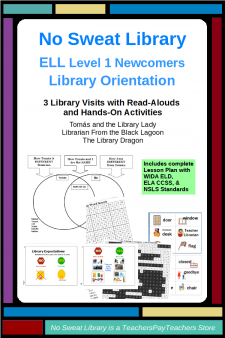 If this set of lessons appeals to you, the full package of the ELL Level 1 Newcomers Library Orientation lesson plan, printouts, and worksheets are available at No Sweat Library, my TPT store.
If this set of lessons appeals to you, the full package of the ELL Level 1 Newcomers Library Orientation lesson plan, printouts, and worksheets are available at No Sweat Library, my TPT store.



